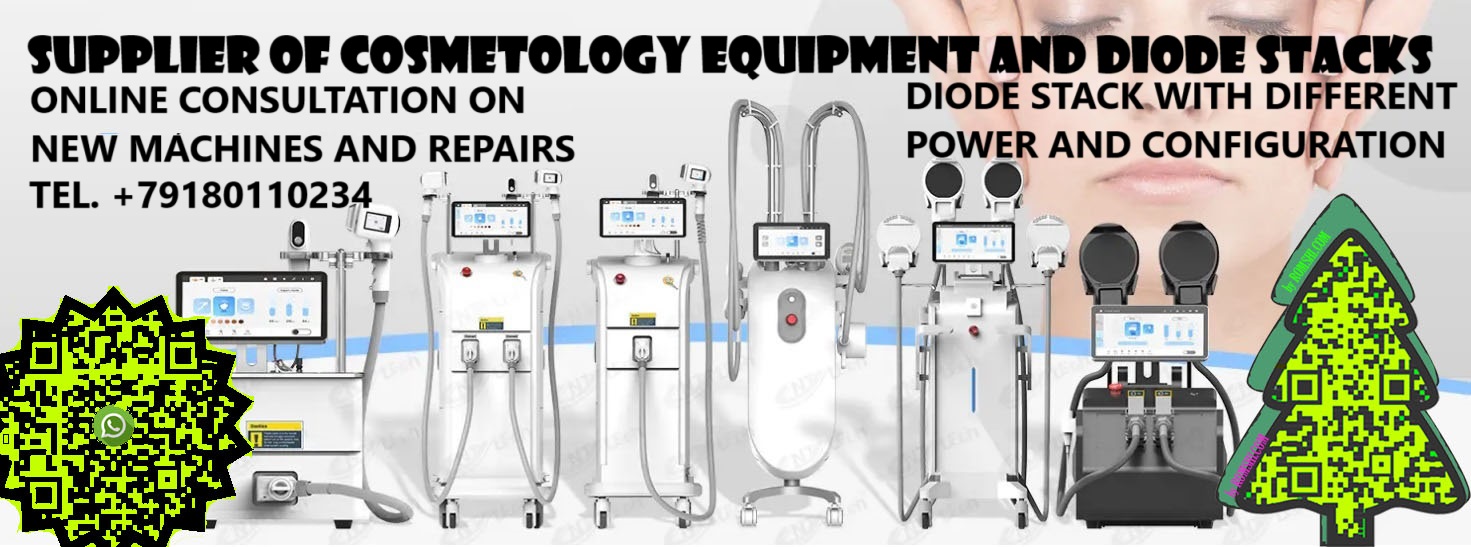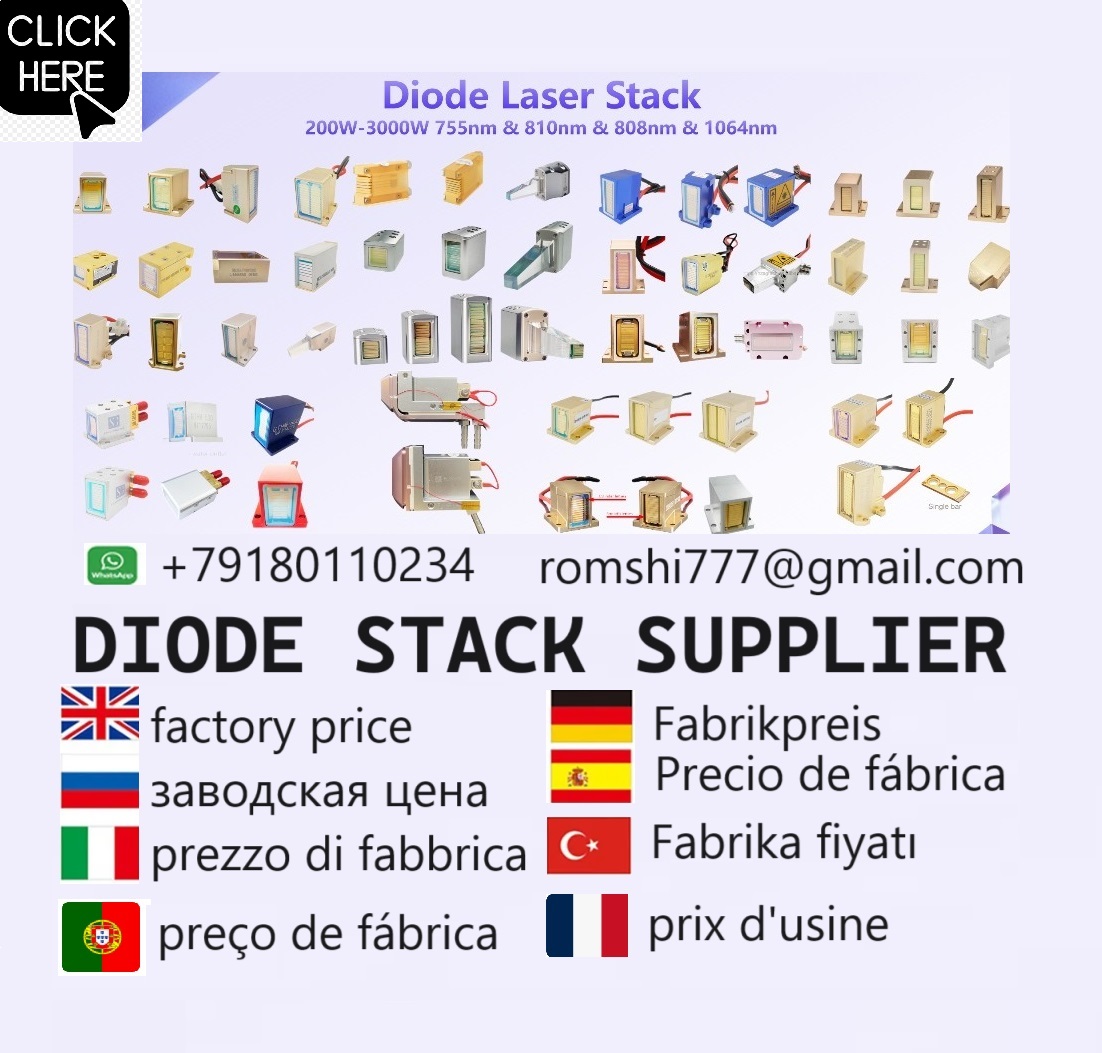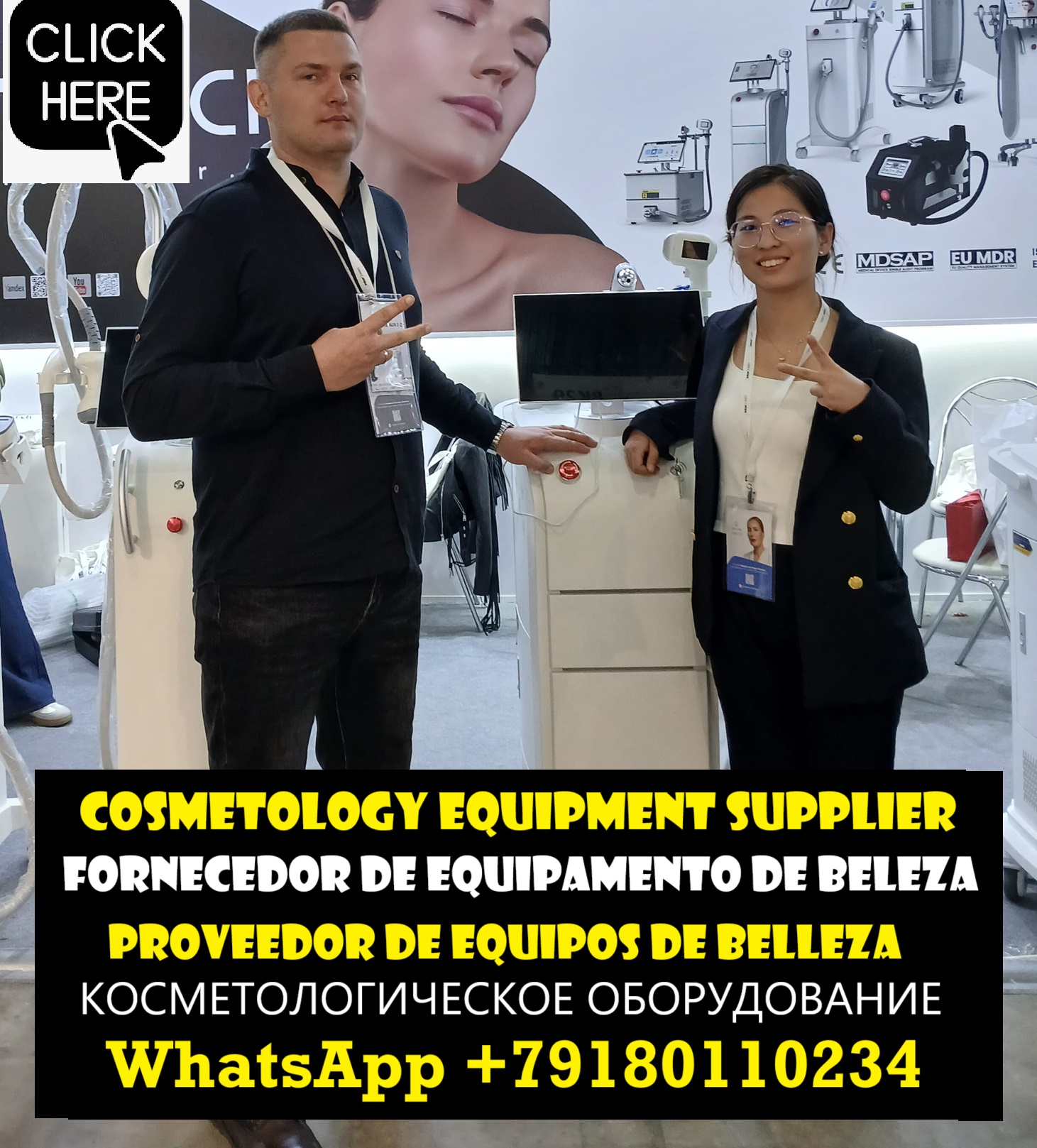Expert ROMSHI talks about lasers
Inspection of a non-working 500 watt 10 bar stack made by HPL. What a burnt bar looks like under a microscope. Article prepared by expert Romshi.
Laser expert Romshi cited the example of a 500-watt diode stack with one bar burned out. This article will help you learn in advance what problems with a malfunctioning ‘heart of a diode laser handpiece’ look like. Photos taken with a microscope will be an interesting addition to the article.
MOST IMPORTANT:
If you are having problems with the operation of the diode laser handpiece, the laser module has burned out, or you simply do not understand the problem, I STRONGLY RECOMMEND THAT YOU CONSULT WITH ME TO SAVE TIME.
If you are a beginner in repairing cosmetology equipment, then I hope you will be interested in reading the information. I represent a manufacturer of diode stacks, which will allow you to purchase a spare diode stack without intermediaries.
Also, these articles will be useful if you want to solve possible problems with your cosmetology equipment yourself. But it is better to consult and thank you for visiting the site.
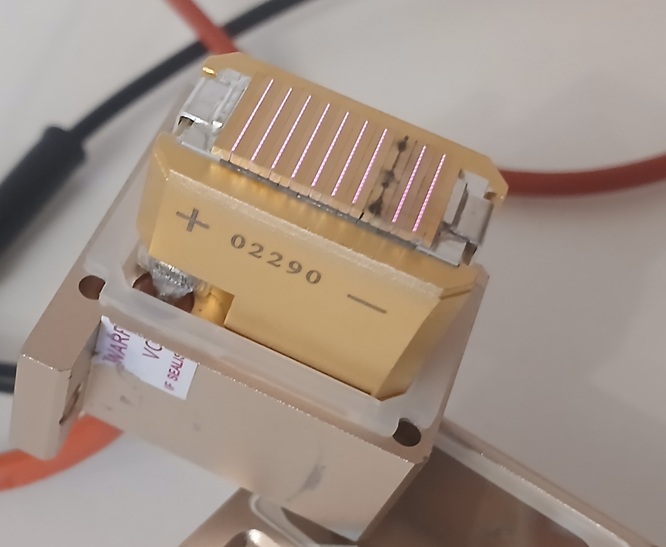
This article by Romshi on diode stacks is for informational purposes only, and I do not recommend disassembling your laser handpiece and diode stack if your diode laser is working properly. However, the purpose of this section is to show beginners how hair removal lasers work and to help them with DIY repairs. Free consultation by phone +79180110234 in messengers WhatsApp, Telegram.
The photos below show a 500-watt 10-bar diode stack with a wavelength of 808 nm. This laser module power is quite common and is one of the options found in diode laser handpieces. In this case, 1 bar out of 10 burned out. Each bar can emit up to watts per ampere if a current of 50 amperes passes through it.
A customer reported that their cosmetic laser had stopped emitting flashes. The model of the cosmetic laser was ALD-1. The customer was asked to send a photo of the diode stack through the window in the handpiece. It was visually clear that the laser module was overheating. There were no flashes at all in the device because the power supply's current protection had been triggered. Only with the help of a separate laboratory power supply unit in the service centre can it be seen that 9 out of 10 plates are lit.
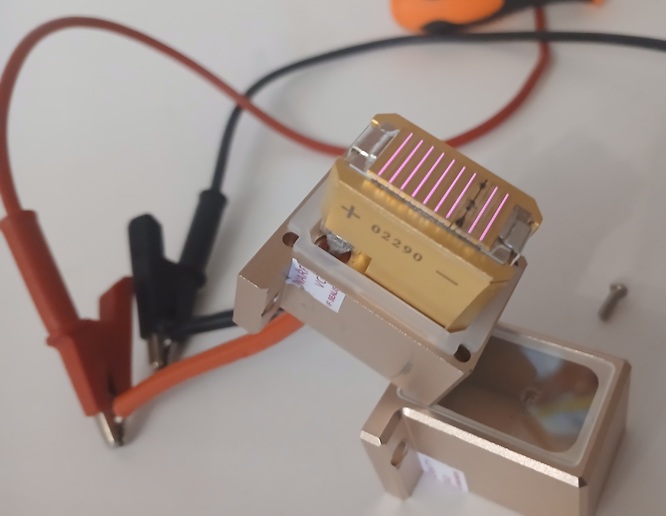
What are the main reasons for the failure of this diode stack? The main reason is overheating of the water and, accordingly, the diode matrix itself. The ideal water temperature is 23 degrees Celsius in the water system of a cosmetic laser. However, I would like to note in this article that the speed of water circulation in the diode laser system is also important. Therefore, it is important to change the filters for cleaning the water system in accordance with the instructions of the laser manufacturers. For Chinese diode lasers, the period is from 3 to months. I would like to note that water filters are usually installed in cosmetic lasers with polypropylene or ion resin. Sometimes both filters or double filters are used. These issues will be discussed in other articles on the website. Another important factor is the frequency at which the flashes are emitted. Ideally, it should be no more than 5 Hz. Also, the lower the power in the settings, the longer the diode stack will last.
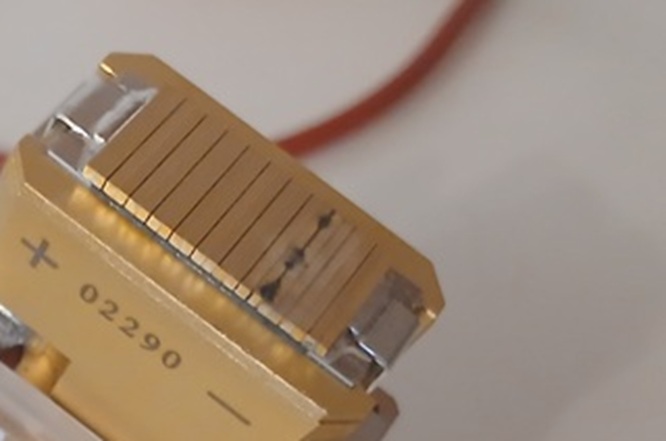
In this case, 17 volts and 1.3 amps are supplied to the diode stack for 1 second using a laboratory power supply unit.

The photo below shows an open diode stack casing for demonstration purposes to readers of my website. However, I do not recommend that you disassemble new working parts, as this may lead to malfunctions. The stack is marked HPL, but in your case, the old diode stack may be marked lst, dvs, ht, hr, hd, or various other markings. Stacks differ in the quality of their bars. We offer DVS and LST diode stacks and are confident in their quality.
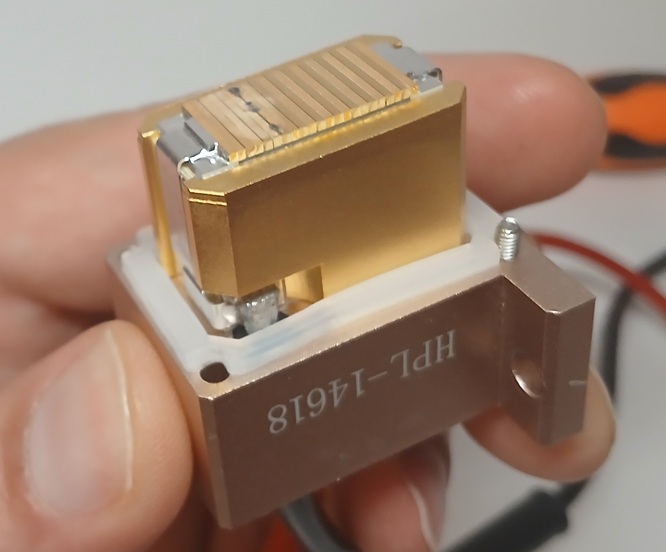
The photos below show a diode stack under a microscope. You can see that one strip (bar) looks different from the others. In this case, the black dots from overheating are really noticeable. This is the easiest way to tell that the diode stack is broken.
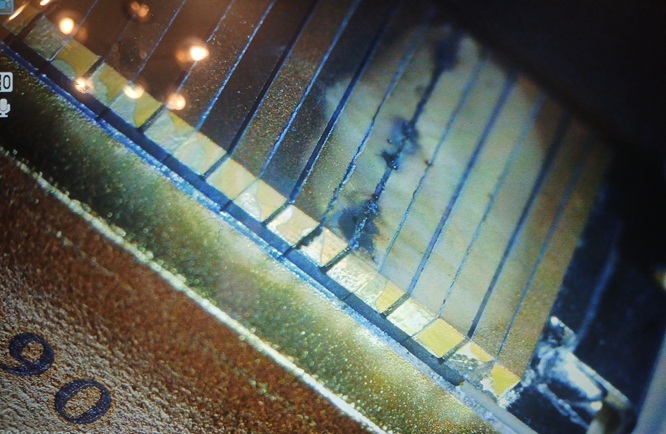
Is it possible to repair a laser manipulator diode stack yourself in your garage using a soldering iron without any experience? - THE DEFINITIVE ANSWER IS ‘NO’. All attempts to ‘revive’ an old stack will not produce the desired effect without special equipment. If you had a 10 bar diode stack, it operated at specific supply voltage parameters. You will not be able to operate normally with a 9 bar stack. (If a 500 watt 10 bar stack was installed in the handle, then a 500 watt 10 bar diode stack must be installed in the future).
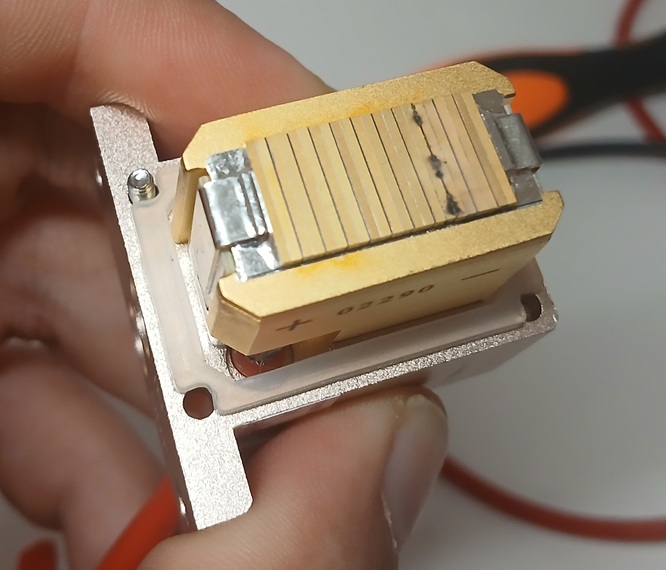
Checking the diode stack with a laboratory power supply allows you to see the bars burning without using a cosmetic laser.
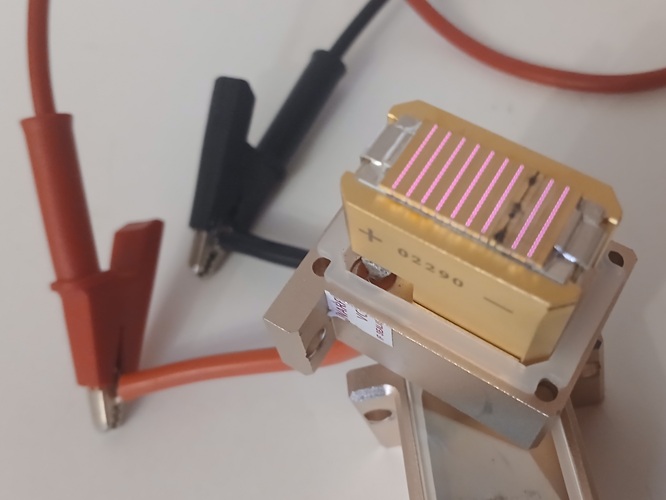
Experience in repairing hair removal lasers has shown that it is not always necessary to trust diode laser sellers, as some manufacturers exaggerate the parameters of their lasers for marketing purposes. If your diode stack has burned out, you need to disassemble the handle and look at the inscriptions on the stack. If you want to find out the power of your handle, please contact us.
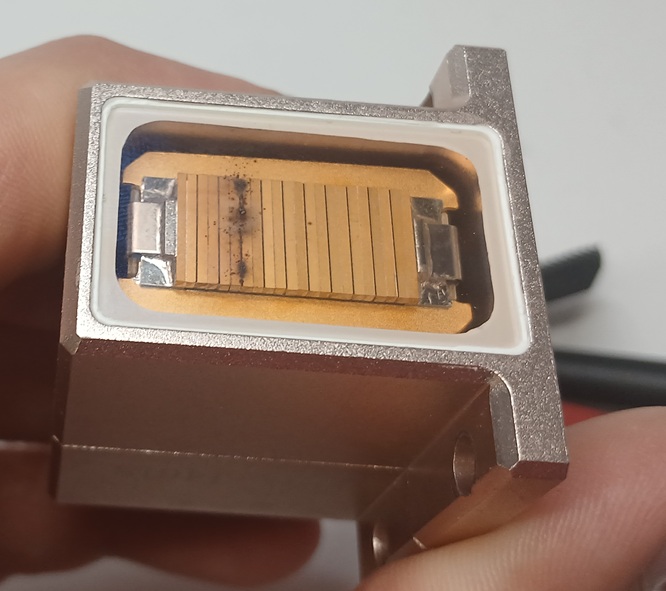
I would like to remind you that the diode laser needs to be serviced and the water system needs to be cleaned, and the internal parts of your laser need to be blown out of dust. The water should be replaced once a month. Do not forget to change the water purification filters (unfortunately, cheap lasers do not have them).
CONDUCTING MAINTENANCE WILL INCREASE THE LIFE OF THE LASER.
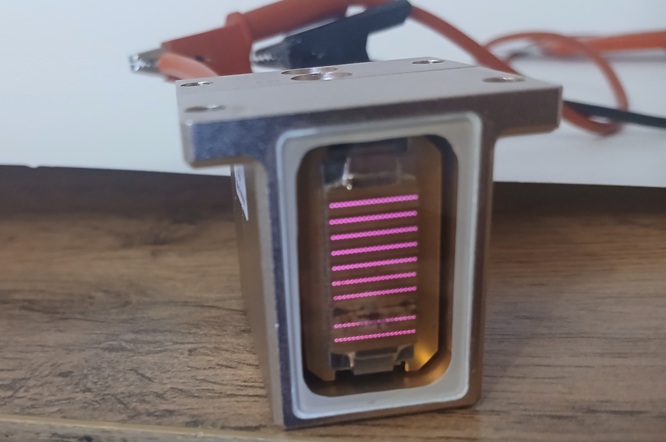
Black stripes on the bars indicate that one of the bars has burned out. In this case, I will repeat, 10 bars. This diode stack is 37 mm high. The manufacturer installs 4 to 12 bars in it in standard cases. The bars have a power of 50 or 100 watts. The standard radiation wavelength is 808 nm, but there are diode stacks with 2 and 3 wavelengths simultaneously. In this diode stack from the manufacturer HPL, there were 10 bars of 808 nm, all with the same brightness.
In some versions of diode stacks, wavelengths of 755 nm and 1064 nm are used, and the most interesting thing is that 1064 nm is not visible to the human eye, but can be seen through mobile phone cameras.
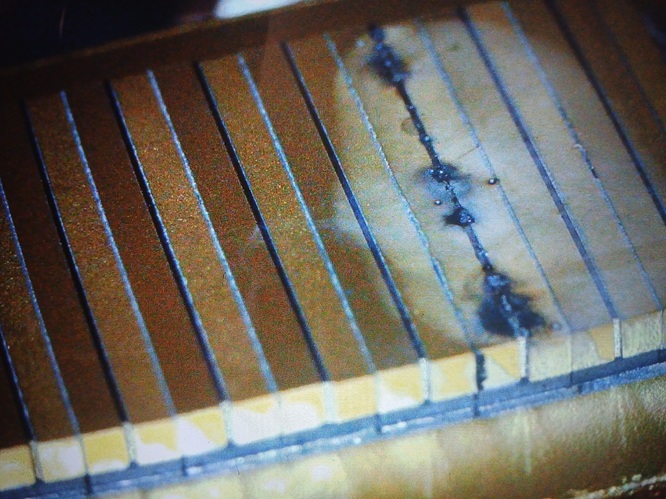
Another photo of diode stack bars under magnification. In this case, a macro channel stack.

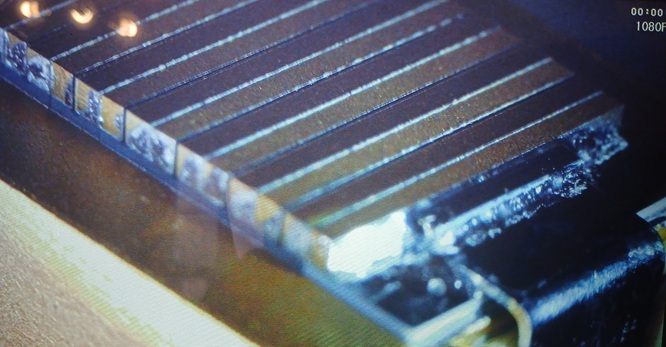
Photo under a microscope of laser bars soldered from the side. This is a macro channel diode matrix, and the bars are soldered in a row on a ‘substrate.’ Poor soldering will result in the failure of the diode stack. AN INTERESTING FACT IS THAT DIODE STACKS OFTEN STOP WORKING NOT BECAUSE OF BURNT BARS, BUT BECAUSE OF SOLDERING PROBLEMS. Due to poor soldering, the required current does not flow and the power sources go into protection mode.
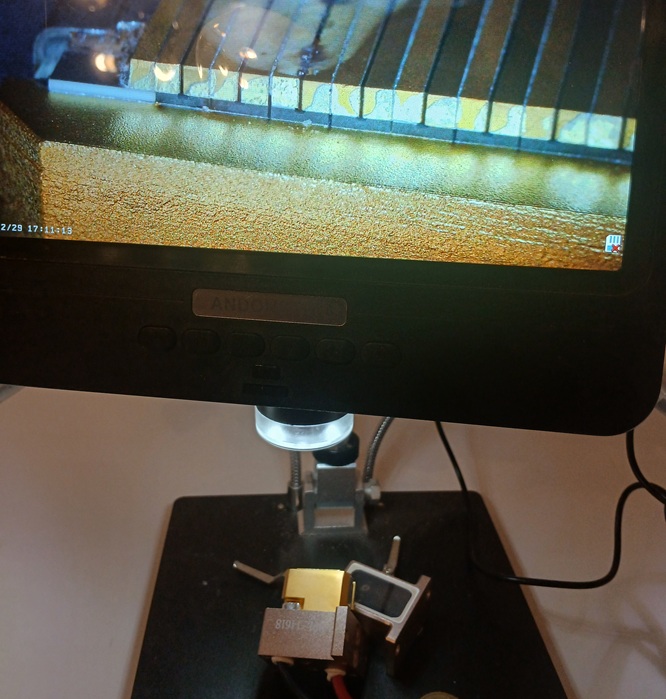
This article was written by Romshi, an expert in cosmetic lasers. I have tried to include a sufficient number of photos of a non-functioning diode stack, including some taken with a microscope. If you are having problems with your diode laser, you can consult us about purchasing diode stacks. We also offer new diode lasers for hair removal at factory prices. These feature modern design, an Android system, worldwide delivery of cosmetic equipment, quality assurance, and international certifications. For consultations, please call +79180110234 (WhatsApp, Telegram).
Finding parts for repairing hair removal laser handpieces is important for novice technicians from different countries. One of my areas of expertise is repairing hair removal lasers, and I am a supplier of diode stacks of various power ratings and configurations. I work with repair technicians and retail customers from around the world. I am always ready to help people from other parts of the world. Write your question and I will try to help you. With respect to all, Romshi.
How to choose a diode laser for hair removal - choosing a hair removal laser.
What is an 808 nm diode stack, types, testing, and replacement - link about choosing diode stacks.
I also recommend reading the following articles on the ROMSHI.COM website.
We offer modern diode lasers for hair removal - link to diode lasers for hair removal
This was the column "Expert ROMSHI talks about lasers".
Peltier elements in diode lasers. How the cooling system of the handle for comfortable hair removal works.
The Peltier element in the diode laser handle device is simply explained as follows: a special flat plate that becomes HOT on one side and COLD on the other when voltage is applied. Thanks to its operation, the tip of the diode laser remains cold. Read more below.
Peltier elements are an important part of the diode laser handpiece for comfortable hair removal procedures. In this article, ROMSHI experts will provide examples of photos of repairs and spare parts from hair removal laser repair projects. The photo below shows a small selection of Peltier elements for cosmetic lasers. Free consultation on problems with hair removal lasers by calling +79180110234 on WhatsApp or Telegram.
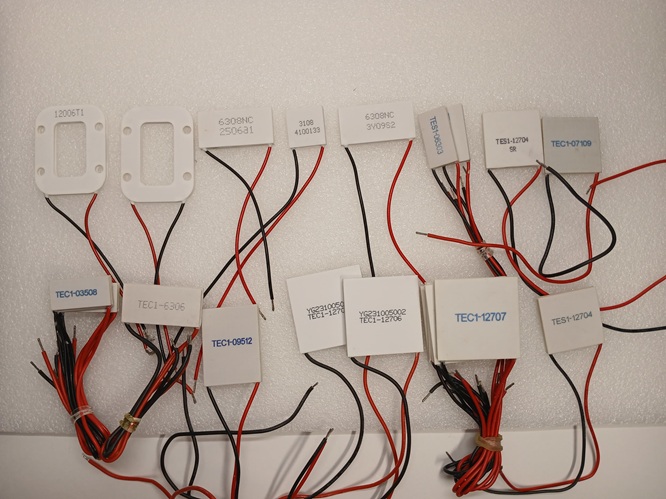
This article was written by Romshi, an expert on diode lasers for hair removal. If you use a laser in your work, you may have noticed that the laser tip becomes cold during operation. Peltier elements are responsible for cooling the tip. Their integrity affects stable cooling. The article includes photos of laser handles and Peltier elements, tips for checking them, and some nuances of repairing hair removal lasers.
The photo shows square, rectangular, and oval Peltier elements. A Peltier element with one size, for example, 30*30*3 mm, can be designed for different currents. Tec-12704 and tec-12709 differ in their maximum permissible operating current. However, the opposite can also be true: the inscription on the Peltier element tec-12704 can be found on parts measuring 30 x 30 mm, as well as on parts measuring 40 x 40 mm. If you have determined that the Peltier element is faulty, it must be replaced with one that has the same geometric dimensions and is designed for at least the same current.
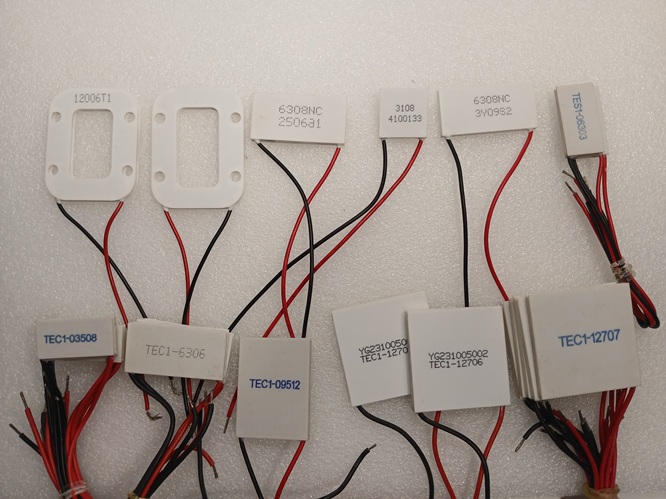
Peltier elements are plates with two sides. When a constant voltage is applied to the plate, one side becomes cold and the other side becomes hot. In diode laser handles, the cold side becomes cold, and the other side usually touches the aluminum interior of the handle, through which water circulates. The water dissipates heat and also passes through the diode stack, where it also dissipates heat. It is worth noting that the water system in a diode laser device plays an important role, but its design will be discussed in other articles in this section.
The photo below shows a disassembled adss fg2000b diode laser pen. This pen has two Peltier elements. Usually, if one element fails, the second element is still functional.
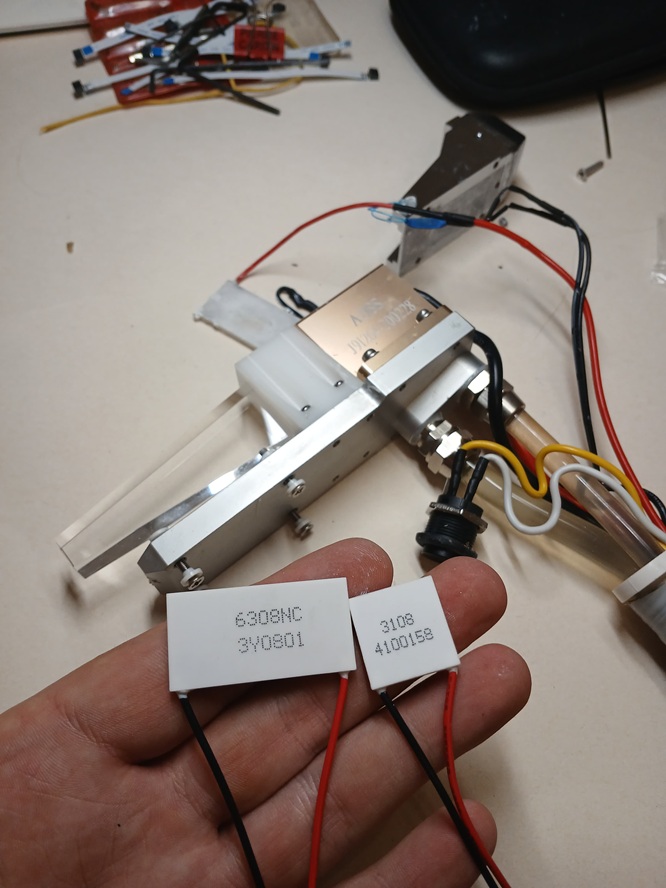
Peltier elements used in diode laser handles come in different shapes (square, rectangle, oval) depending on the manufacturer of the cosmetic laser and the design of the handle. The article provides photos of various options. IT IS IMPORTANT TO NOTE THAT PELTIER ELEMENTS ARE LUBRICATED WITH THERMAL PASTE FOR BETTER HEAT TRANSFER. Ideally, the thermal paste should be replaced every year to ensure that the diode laser handpiece cooling system works properly. This can be done yourself if you get advice and do everything carefully. By the way, FREE CONSULTATION is available by phone at +79180110234 on WhatsApp, Telegram (ROMSHI).
How to use thermal paste for applying to Peltier.
1. You need to remove the old thermal paste, for example, with wet wipes.
2. Before using a new Peltier element, I recommend testing it with a multimeter with a resistance of several ohms. Another method is to take a battery and attach it to the ends of the Peltier wires. This is a simple way to check in a fraction of a second whether the sides of the Peltier element are cooling and heating.
3. Apply a thin, even layer of thermal paste to the new Peltier element and carefully reassemble the pen. For repairs, I often used thermal paste to cool computer processors.
4. Once the pen is assembled, test it on a working laser device.
The photo shows an example of an oval Peltier element. Different laser manufacturers use different Peltier elements. It is important to consider the size of the old Peltier element in order to order the correct replacement part.
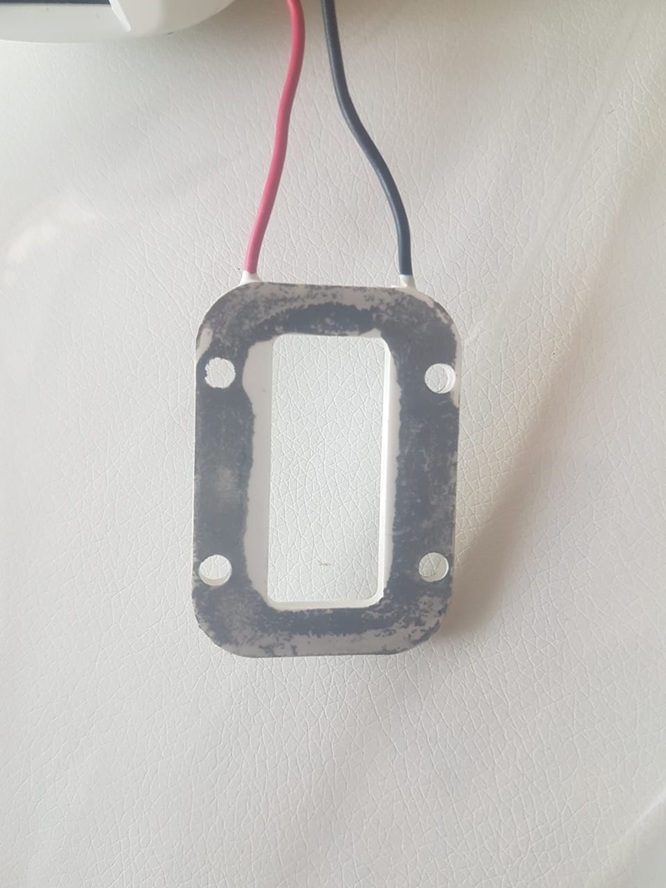
Let's consider an example related to the problem of cooling the handle of a cosmetic laser. The main repair request: the laser tip is no longer cold and quickly becomes hot. The following problems can be identified with poor handle cooling:
1. Faulty Peltier element.
2. A broken wire in the handpiece through which voltage is supplied to the Peltier element.
IMPORTANT NOTE: Some handpieces have several Peltier elements installed at once. I have seen 1-4 Peltier elements in a diode laser handpiece at the same time.
3. Problem with the power supply or sometimes with the connector on the circuit board. That is, a large current is supplied to the Peltier element and the connector burns out and no longer conducts electricity well.
4. The thermal paste has not been changed for a long time and has become too dry for normal heat transfer.
If you need advice on the repair and maintenance of cosmetic lasers, please feel free to contact me. Free online consultation by phone +79180110234 via WhatsApp or Telegram.
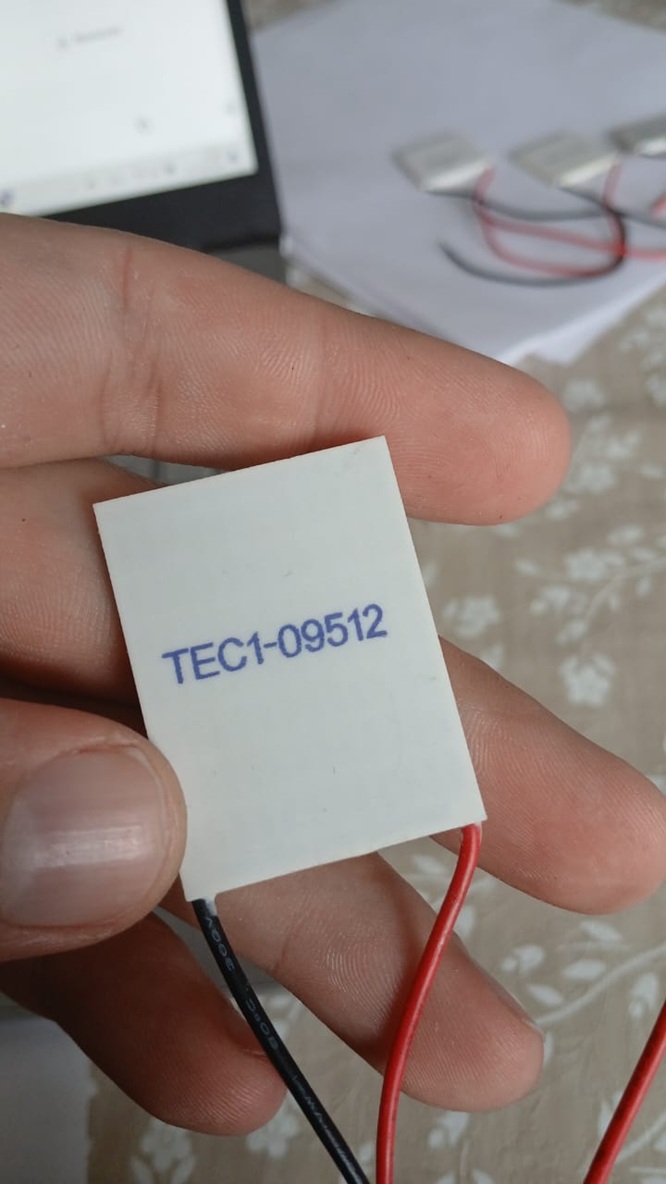
When repairing laser handpieces, visual inspection is often important. I recommend carefully disassembling the handle and checking the integrity of the wires. If you remove the handpiece connector from the device, you can check the resistance of the Peltier element using a multimeter. Many people have a multimeter in their household.
This material was compiled for you by Romshi, an expert in the repair of diode lasers for hair removal. Peltier elements are an important component of any diode laser handpiece in the field of cosmetology. There are a huge number of devices and a wide variety of Peltier elements on the cosmetology market. But if you have a cooling problem, the first thing to check is the Peltier elements.
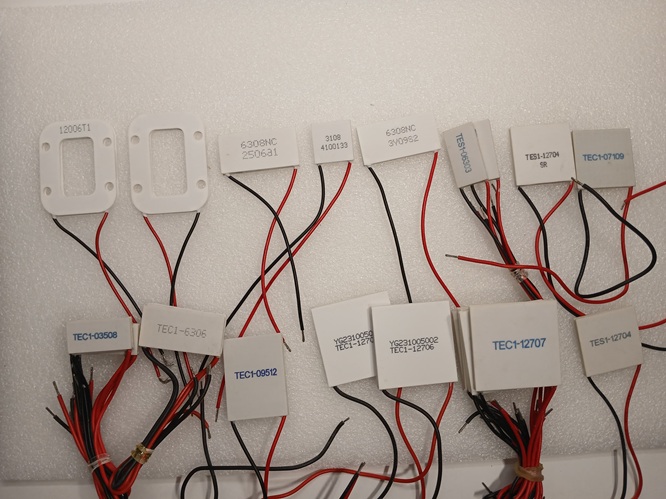
Another important note about Peltier elements. In my experience repairing hair removal lasers, I have noticed that the laser handle can become cold, but when radiation is applied, the tip quickly heats up. In such situations, I recommend replacing the Peltier element with a new one. IMPORTANT: Peltier elements have a model designation on one side. When the voltage polarity is selected correctly, the side with the inscription becomes cold.
I also recommend reading the following articles on the ROMSHI.COM website.
How to choose a diode laser for hair removal - choosing a hair removal laser.
What is an 808 nm diode stack, types, testing, and replacement - link about choosing diode stacks.
We offer modern diode lasers for hair removal - link to diode lasers for hair removal
I would like to note that Peltier elements are also used in tec modules, which are used to cool water in, for example, adss, honkon, and mbt lasers. This is a topic for another article about the features of the water cooling system for diode lasers.
Laser diode stack 808nm: differences, how to check and change. Article from ROMSHI hair removal diode laser repair expert. What to do if the hair removal laser does not give the effect of hair removal!
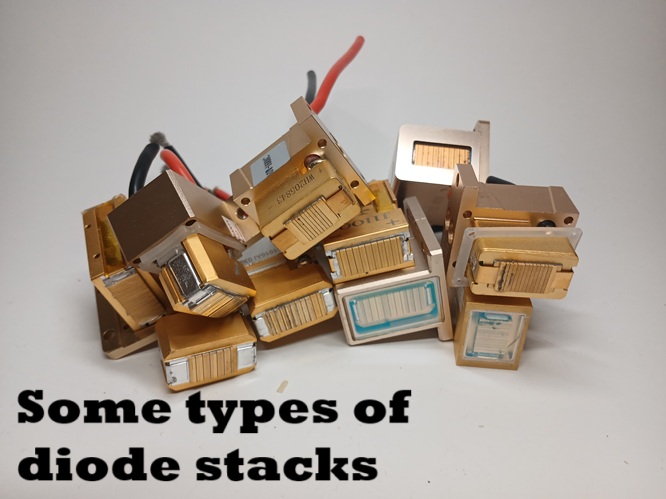
How to understand whether the diode stack is working, how to change it in the laser handle, where to buy and nuances - you will learn this from the article by the expert on diode lasers ROMSHI.
The main reason for requests for repair of diode lasers from the practice of repair: when pressing the button of the manipulator stopped going flashes, there is no characteristic light from the window of the handle. A characteristic feature that on the screen works flash counter, but in reality flashes do not occur. This means that the button in the device is intact and the software works, but the diode stack power supply unit "goes with current protection". That is, the required current (for example, 40 amperes) simply can not pass through the diode stack and immediately triggers protection. Often the problems can be seen visually.
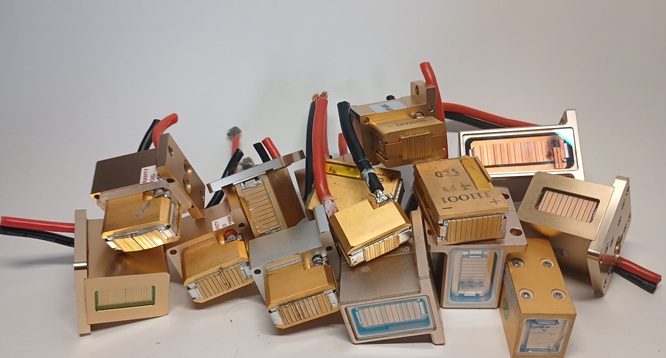
MAIN DIFFERENCES OF DIODE STACKS.
What is a diode stack in simple words: a part that is located in the handle of a diode cosmetic hair removal laser. Synonyms for diode stack: laser emitter, laser module, diode stack, laser bar, diode matrix, diode assembly to name a few. This part emits light with a wavelength of 808nm, which allows for so-called “laser hair removal” when interacting with human hair. These parts differ in the number of bars ("luminous bands" when the laser is working), the power of each bar ( usually 50 or 100 watts for 1 bar), the height of the part itself ( 37, 47, 49 , 52 mm and other variants), the length of radiation ( standard 808nm, but there are 1064, 755, 810 nm), the color of the diode stack body itself ( gold color, blue, red) and inscriptions ( for example lst-1010ai, dvs-1010ai, ht10500 denote diode stack 500 watt 10 bar 808nm and these are interchangeable analogues). Agree that it is easy for a beginner to get confused, and in case of emergency repair, you need to solve the problem quickly. This is the most expensive part of the cosmetic laser and it has problems mainly due to overheating, as the ideal temperature of water is 23 degrees Celsius (note briefly that when the diode laser is working, heat is generated and the diode stack must be cooled and distilled water is used to remove heat. Filters are used to purify the water and radiators, tec modules and in some units Freon compressors are used for cooling. This is very brief and more detailed in other articles on ROMSHI.COM). In this article Romshi expert tried to show various nuances about diode stacks.
INFLUENCE OF WINDOW SIZE ON DIODE LASER EFFICIENCY.
I would like to point out that for laser hair removal efficiency it is important to consider energy density, i.e. consider the area of the handle window and the power of the diode stack. Many laser manufacturers in China deceive their customers with stories about laser power. Below I will give several examples so that you can see the differences visually. Some conscientious manufacturers of cosmetology equipment produce 1 version of the laser, but with different sizes of the handle window. The larger the window, the more the manufacturer sets the power of the diode stack. Hence the conclusion - if the purchased laser is not very effective from the very beginning, then it is possible to replace the laser handle. Yes, it costs extra money, but you will get results.
The photo below shows a large window when compared to a diode stack. Visually, the bars take up only part of the space. The handle has a 600 watt 12 bar diode stack, but this is a small power for the overall size of the handle window. Ideally, there should be a 1200-1600 watt stack there.
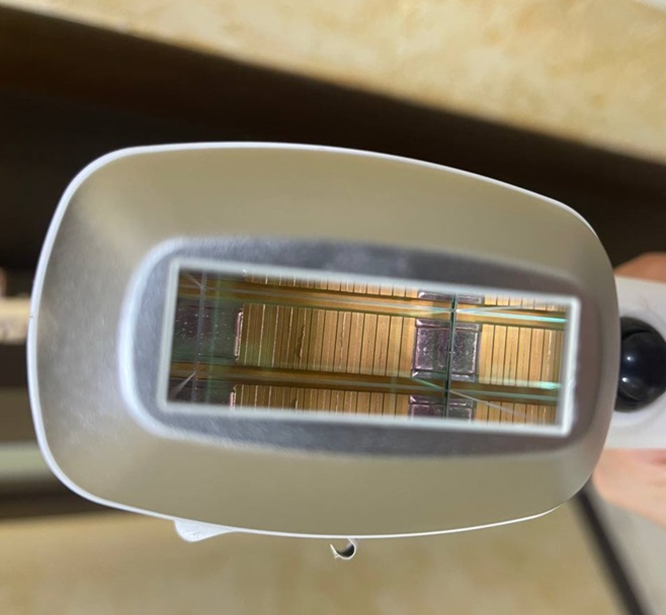
The photo below shows a stack with burning bars. In this case, it is more than 1000 watts, since the stack is micro channel. 1 plate produces up to 100 watts.
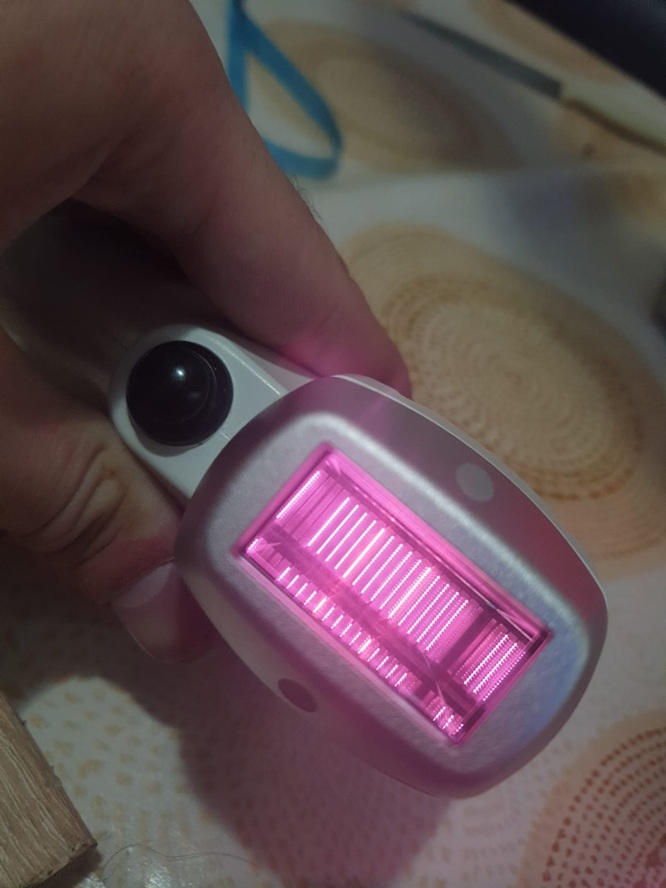
HOW TO CHECK A DIODE STACK USING A LABORATORY POWER SUPPLY UNIT.
This photo shows an oscillograph when checking the operation of the diode laser hair removal handle. It is visible that there are surges and probably problems with the electronic part.
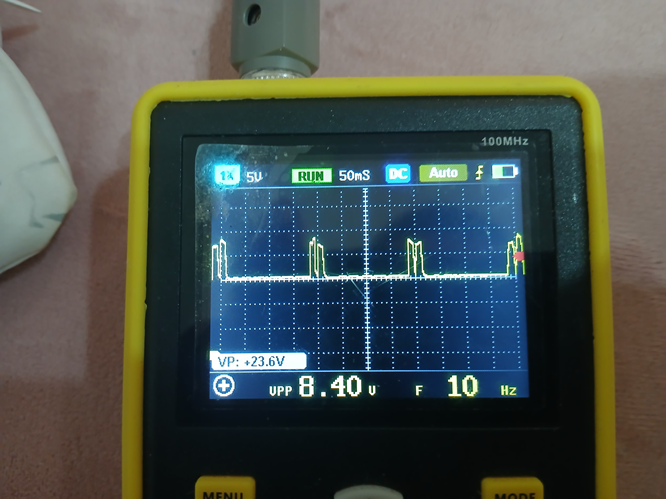
This photo shows a 808nm diode stack, where you can visually see that the brightness of its bars is different. In this case, the problems were caused by problems with the electronic part of the laser.
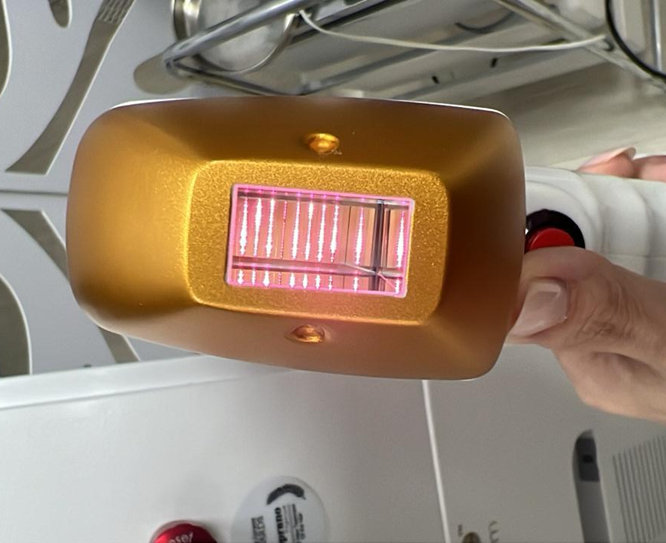
A diode stack operates when a voltage of no more than 1.8 volts is applied to 1 bar. The number of bars in diode stacks may vary. For example, diode lasers often have a 500 watt 10 bar diode stack. This means that 1.8*10= 18 volts of direct current of a certain shape will be applied to this part during operation. The part itself is designed for a current of 50 amperes. To test the diode stack I use 1.7 volts multiplied by the number of bars and a current of 1.3 amperes. This is enough for the bars to glow in a working diode stack. In a non-working diode stack there will be no radiation or not all bars will light. IMPORTANT NOTE: sometimes the diode stack glows evenly from the lab power supply, but when used in a laser there is no radiation. In this case, the current protection in the laser hair removal device will be triggered, since there is probably poor soldering inside the diode stack and the required current cannot pass in the required amount.
BRIEF INSTRUCTIONS FOR REPLACING THE DIODE STACK IN THE HANDLE OF A COSMETOLOGY LASER.
1. The problem was determined to be a degraded diode stack. It may be black dots on the bars, tin that has come out and shifted bars from their places (everything should be symmetrical, like on a new one), water drops inside the diode stack (it should not be and it indicates problems with sealing the laser module), broken glass on the side of the bars, the light from the brightness of the bars either stopped shining at all - or became uneven and other visual problems.
The photo shows problems with the prism and the protective glass of the diode stack. In this repair of the laser handle, it will be necessary to change the prism and the diode stack. In some cases, it is impossible to find a prism and we can offer completely different laser handles instead of the old one.
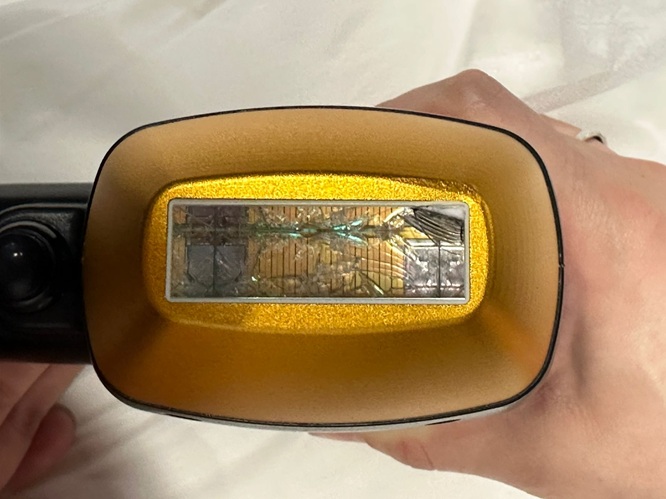
The photo shows problems with damaged burnt bars, as black stripes on the parts are visible. You can immediately see that the parts also differ in height. The number of bars in both cases is 10 pieces. But the left stack is 1000 watts, the right one is 500 watts.
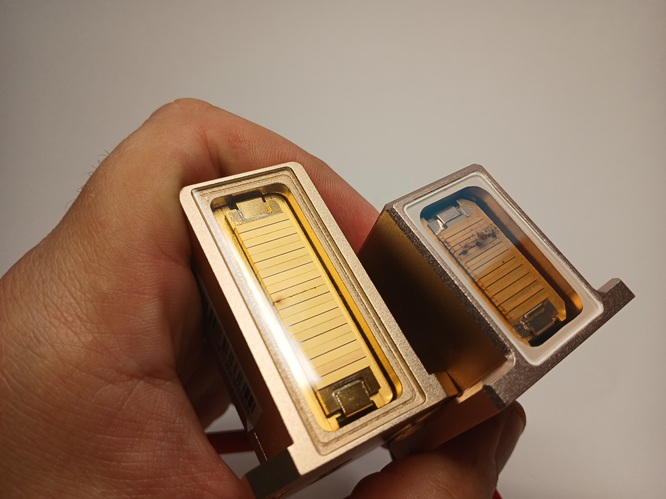
In this photo you can see that 1 bar just "floated" on the molten tin. This is a sign of overheating. This is a common problem in diode stacks if the device does not provide high-quality water cooling. Buying the cheapest laser is not the best idea in my opinion. I offer my clients only high-quality equipment.
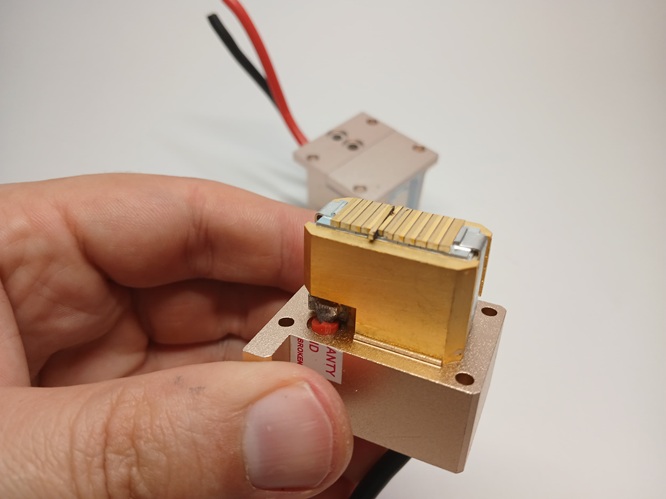
2. You need a replacement diode stack separately and I can offer these parts at factory price. Sending spare parts and shipping worldwide from China and Russia. Our advantages: quality, minimum price and online consultation on replacement. Quick consultation by phone +79180110234 in whats app, telergam ( ROMSHI laser repair expert ).
3. Disassemble the plastic body of the diode laser handle. Some handles have hidden bolts, so you need to do your work carefully. IT IS IMPORTANT TO TAKE PHOTOGRAPHS OF ALL STEPS SO AS NOT TO "GET CONFUSED WHEN ASSEMBLYING the handle back". I advise you not to rush, since some laser handles have an information screen and there are thin wires inside that can be torn off when disassembling the handle.
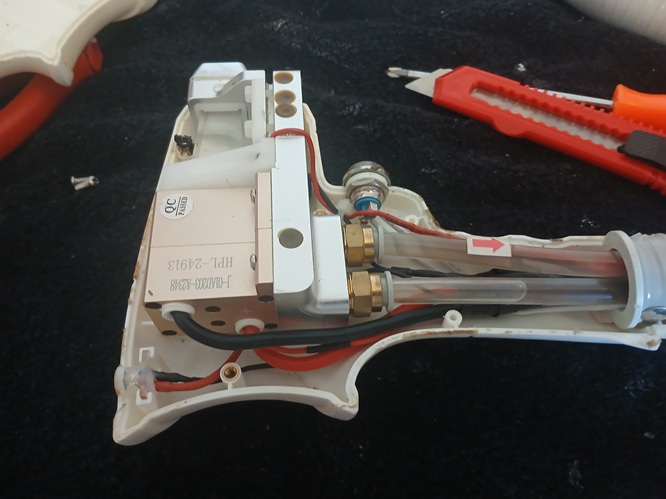
4. When you have opened the plastic case - you will have to replace the diode stack itself. Pay attention to how the wires are located, how the old diode stack is located. You will need to solder 2 wires of the new diode stack and solder them in the same way as the old ones were soldered. This is about 10 cm from the diode stack. The wires need to be soldered well with a soldering iron, and not just twisted without soldering with tin. In diode lasers, the current from 30 to 95 Amperes will flow through the wires and high-quality soldering is required. I REPEAT THAT I can provide free consultation). The manipulator also has a prism, which is located at a distance of 1 mm from the glass of the diode stack. The surfaces must be clean, and for cleaning I use wipes for optical surfaces. If there is dirt on the prism, the dirt can burn. After soldering the wires, you need to assemble the handle body and you can go around the perimeter with a small amount of silicone. This will prevent dirt from getting inside the handle in the future.
5. After replacing the diode stack, you need to check the voltage signal. The ideal test is with an oscilloscope to see the voltage waveform. The diode stack shines with a frequency of 1 to 10 Hz when the laser is operating. Usually the voltage signal is no more than 1.8 volts per 1 bar. I will give a few examples for a clear understanding. If you have large voltage surges, then there are probably problems with the power supply and this can quickly spoil the new diode stack. THIS IS AN IMPORTANT PART OF REPLACING THE DIODE STACK IN THE LASER EPILATION HANDLE. I want to warn you again so that problems do not arise. Do not miss the opportunity to write for advice.
6. After replacing the laser module and checking the electronic part, you need to clean the device from dust and clean the water system. To blow out dust, you can use a compressed air can. If there is a lot of dust on the radiators, then the water cooling is worse and slower and, therefore, the diode stack will last less. The higher the temperature of 23 degrees Celsius, the shorter the service life of the diode stack.
This photo shows a damaged laser handle prism. Even if your diode stack is intact, you MUST change the damaged prism. If you do not change the prism, the radiation from the stack will be reflected and it will overheat and damage itself. There should be no stains or dirt on the prisms in the path of the light beam.
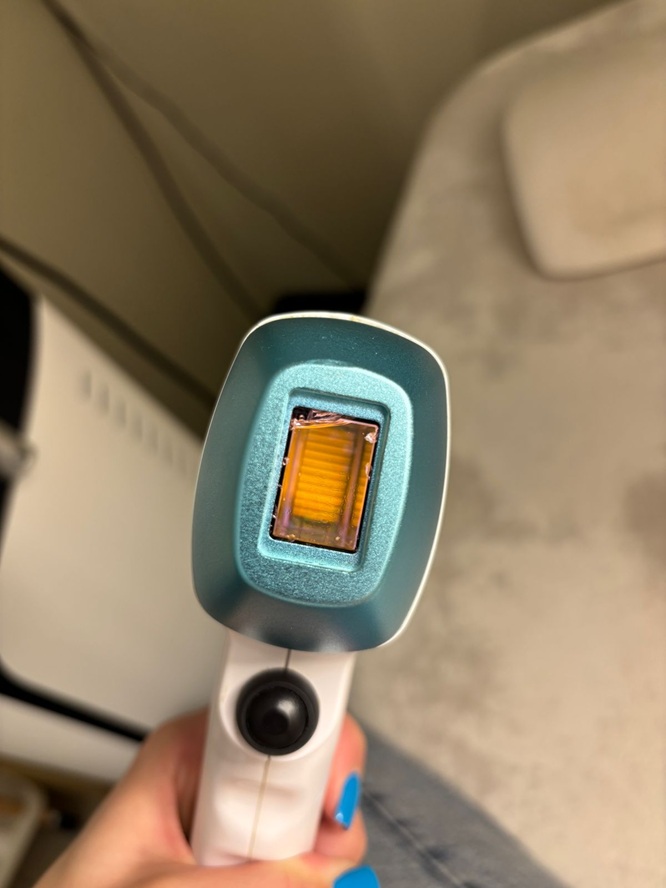
This photo shows the problems of visually burnt diode stacks. Such stacks were replaced with new ones.
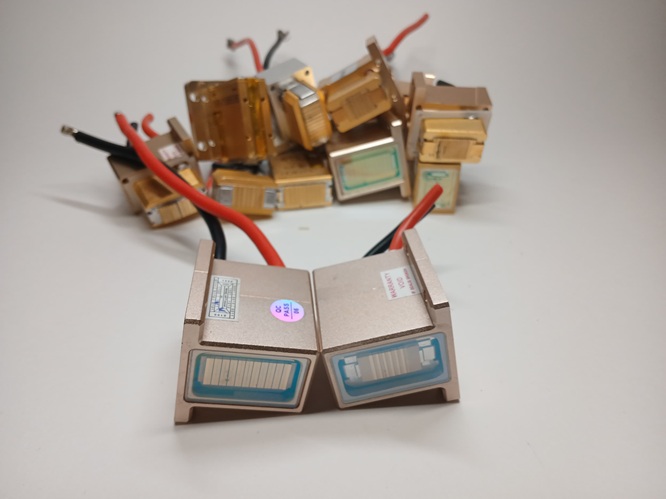
This photo shows an example of the internal structure of a macro channel diode stack. That is, there are bars on 1 plate. This is an article with examples of macro channel stacks.
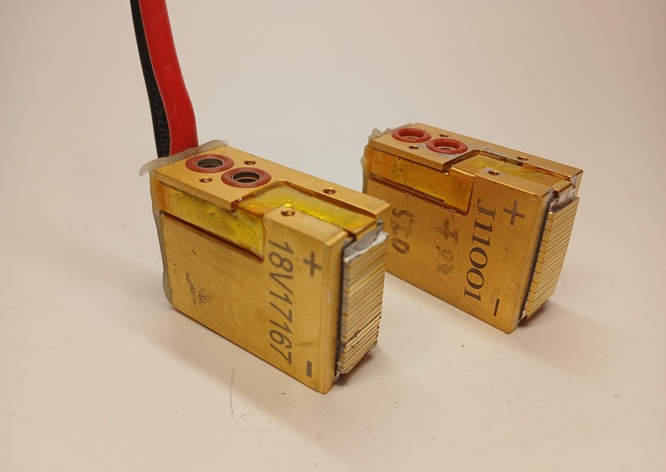
This article was compiled for you by Romshi, an expert in diode laser repair for hair removal. The laser diode stack is the “heart” of a diode laser for hair removal and the most expensive element in a diode laser. The standard emission length is 808nm, which is effective in removing human body hair. If after laser hair removal procedures stopped “hair loss”, then the frequent problem is a burned diode stack.
In this article, I will show photos of diode stack problems that I came across in the process of repairing cosmetology equipment. I represent a factory that manufactures diode stacks and can offer quality replacement parts for diode laser repair.
Quick consultation by phone +79180110234 in whats app, telergam ( ROMSHI).
An article about the structure of diode lasers is available at the LINK.
I would also like to note that I can offer modern high-quality cosmetology equipment for a cosmetology office. Upon request, you will be able to see the prices.
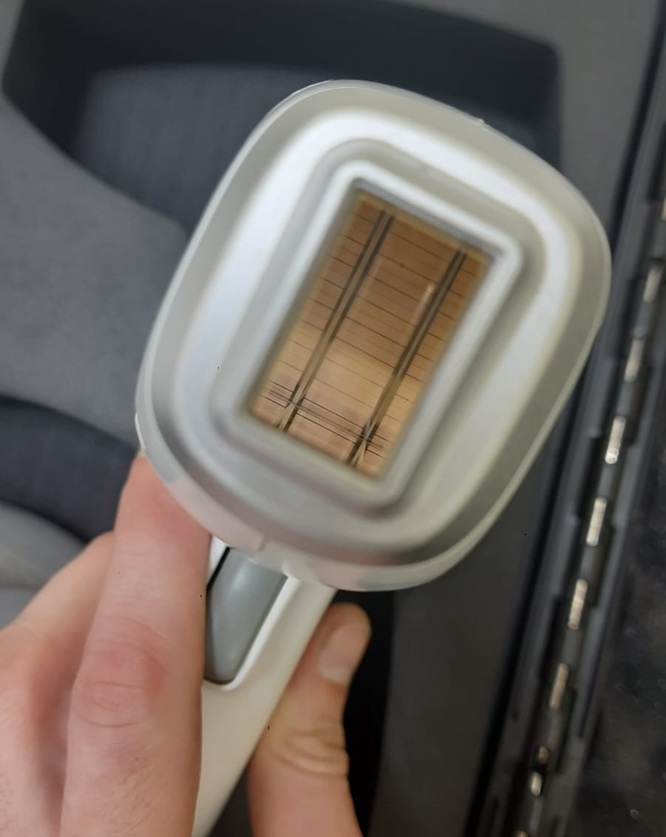
In this article I tried to explain as clearly as possible what diode stacks to choose, how to check them and how to change them. Repair of diode lasers for hair removal requires specific experience, but online consultation will help you to repair your equipment easier. This is the first article in this section.
Quick consultation by phone +79180110234 in whats app, telergam ( ROMSHI).
